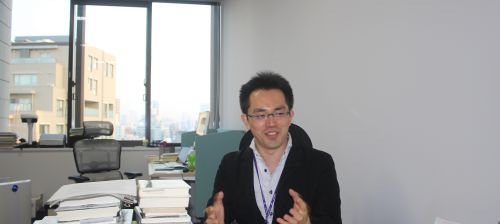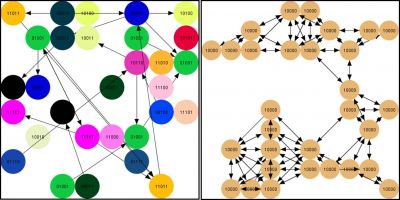TSUKUBA FUTURE
#052 The Workplace Communication Environment
Associate Professor INAMIZU Nobuyuki, Faculty of Business Sciences

The corporate office space in Japan is changing. The norm used to be a large room with identical desks lined up in rows by section. But some progressive firms now offer a training room or an area at the office where employees can mingle and talk, or have created an office that has done away with assigned workspaces. Prof. Inamizu studies such working styles and their correlation to work efficiency as part of business administration studies.
In contrast to the conventional style of assigning one desk and chair to each employee, the office layout principle of not having fixed seating is known as "free address" in Japanese (or "hot desking" in English). Its first use in Japan points to the alternative workplace introduced by Shimizu Corporation at its technical center in 1987. Initially, companies using the new layout were trying to alleviate a lack of space as the amount of office equipment expanded, but in time unassigned workspaces gained attention as a new way of working. The term "nonterritorial office" is also used synonymously with "free address." In the 1990s its popularity spread as a means of improving communication in the workplace. Another benefit is the ability to share the workspaces of employees who have been assigned to an external company or who work outside the office on a regular basis. This effective utilization of unused space is a quintessentially Japanese concept.
Prof. Inamizu first encountered the shared workspace office while studying business administration at the University of Tokyo Graduate School of Economics, and he has since focused on this phenomenon from the perspective of management organization theory. In 2014 he launched an Office Studies Project?a study group to focus on the workplace and working styles. His current research looks at shared workspace offices primarily from the perspective of architectural design. However, social changes have been affecting the office environment, such as work sharing, working from home, and advances in ICT. Consequently, shared workspace offices are being introduced less for design reasons than to improve work-life balance and facilitate communication. People continue to be interested in knowing whether such a system actually does promote communication, and how it might change the way people work.
Prof. Inamizu's Office Studies Project sets out to answer such questions from society by empirically analyzing and studying innovation in the workplace environment from the viewpoint of social science and management organization theory. Through such research it may be possible to clarify the organizational and environmental factors that lead to greater productivity and creativity. One of those key elements is the shared workspace office.

Researchers too need their own room. Prof. Inamizu uses a standing desk in his.
The notion that a shared workspace office system saves space is mistaken, says Prof. Inamizu. In place of assigned seating, other types of spaces are needed for an office to be truly effective. In addition to the shared workspaces, you need to have meeting spaces, private booths for concentration work, reservable seats, and the like. So, in fact you need more space per employee. Reducing the space by 30% will have an adverse effect. You do not want people to be playing musical chairs, so there actually needs to be 1.2?1.3 times the number of seats.
When that is done, what kind of effects will you see? In general, there will be both pluses and minuses. When you have a large room with assigned workspaces, it is easy for employees to have regular communication with those around them, but the reach of their interactions with others is inevitably narrow (i.e. "coarse network"). If you use free seating, there are more opportunities for interacting with a wider range of people, so communication should expand (i.e. "fine network"). Also, a switch to a paperless system often accompanies a shared workspace system, with the shared use of databases and a cloud server. Demerits include anxiety over not having one's own space, so people will often take the same seat anyway, giving little meaning to the new layout; or, it becomes difficult to grasp what subordinates are doing (which results in rising dissatisfaction among middle managers).

Simulation of communication networks.
Communication does not necessarily improve the bigger the space.
Left: An appropriate size. Individuals are not isolated and are loosely integrated.
Diverse cultures can coexist.
Right: A big room.
Those close to one another have strong ties but get consolidated into the whole.
A dominating culture is formed.
The key is balance. It cannot be said unconditionally that converting an office to a shared workspace system will stimulate communication or improve the organization's performance, and by extension lead to innovation. The topic is difficult to assess objectively. Prof. Inamizu conducts surveys in the field and also does research using computer simulations. For example, he postulates coarse and fine networks and sets conditions such as few or many spaces for formal talking (meetings), and evaluates problem-solving abilities. Prof. Inamizu has been awarded the Behaviormetric Society of Japan Awardsfor this research, which he has also developed into a book written in Japanese ("Communication and Decision-Making in a Fluid Organization: Agent-Based Approach"). In practice, changing the space in an office will promote better communication. However, the real problem lies in what kind of organization management wants for the company, Prof. Inamizu insists. Building an organization based on a clear policy and using a particular working style to achieve that is the perspective from which the professor aims to approach further research.
Article by Science Communicator at the Office of Public Relations


